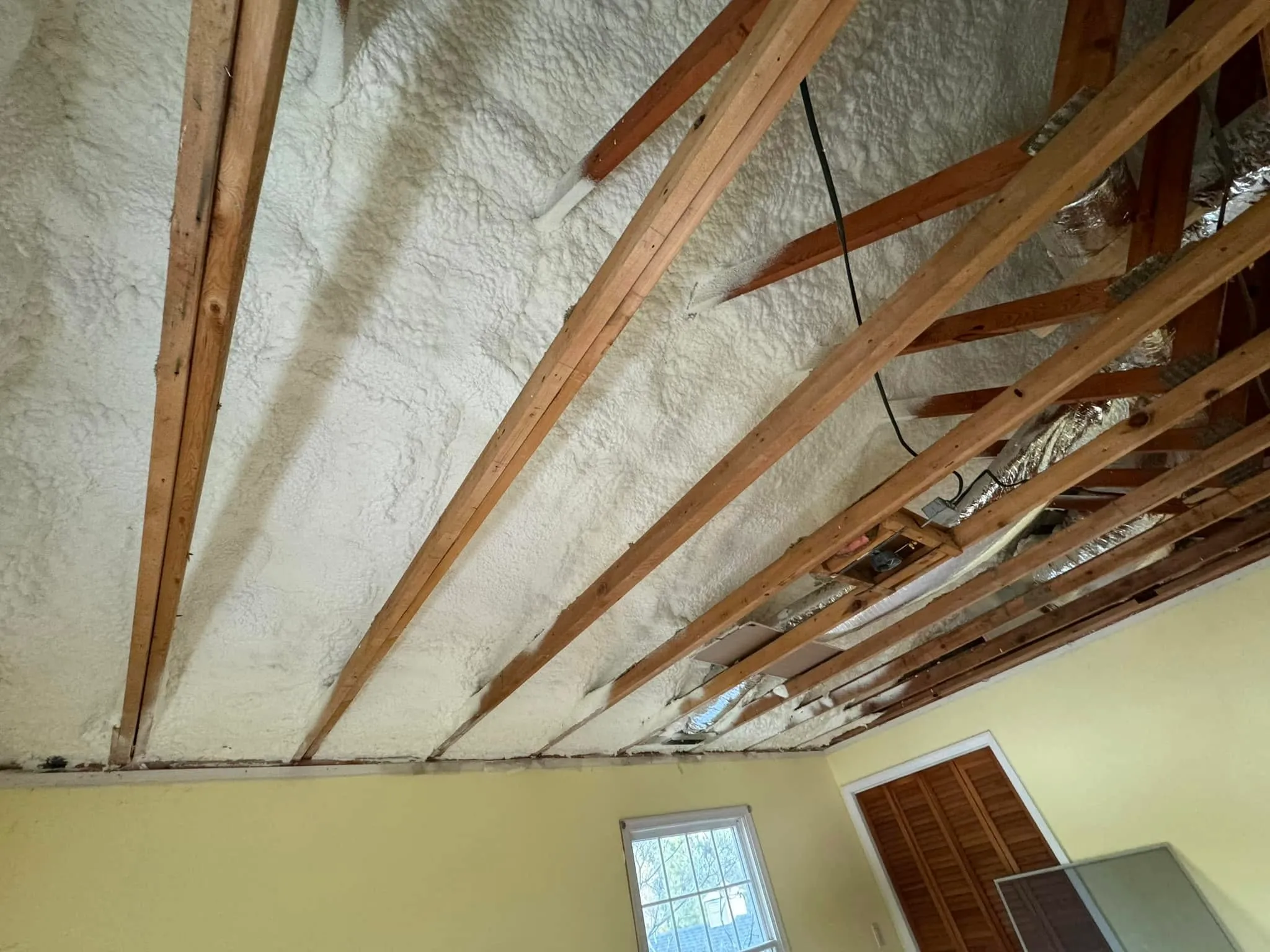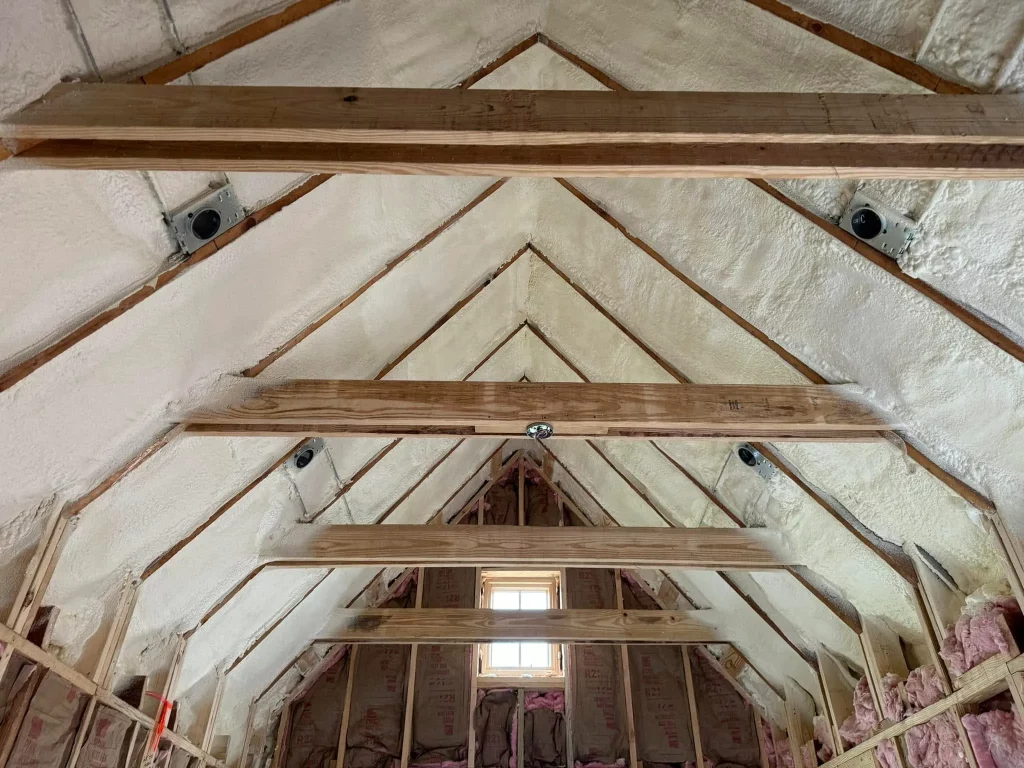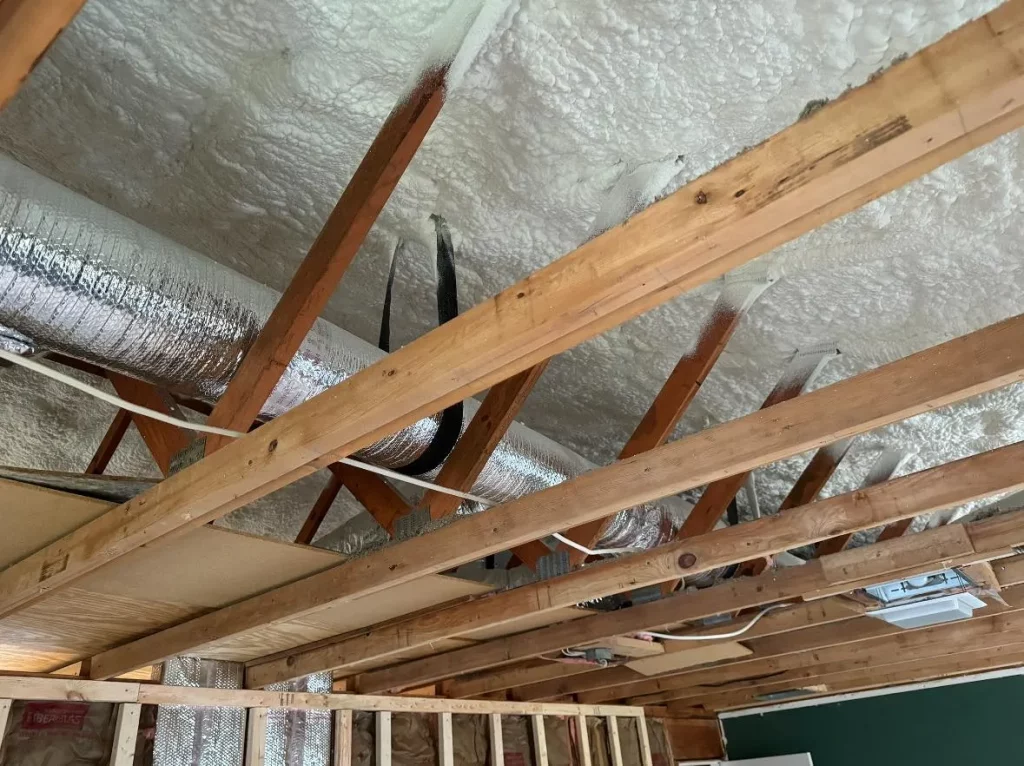
Imagine coming home on a freezing winter day to a house that feels drafty and cold, no matter how high you crank the thermostat. Or dealing with skyrocketing energy bills that eat into your budget every month. These issues affect millions of homeowners and building owners across the country. Spray foam insulation offers a smart solution to these problems by creating a tight seal that keeps conditioned air inside and harsh weather outside. This guide covers everything you need to know about spray foam insulation, from its basics to how it performs over decades.
Spray foam insulation is a versatile material made from two chemicals that mix and expand on site to form a foam. It fills gaps and hardens quickly, providing both insulation and an air barrier. Unlike traditional materials like fiberglass batts or cellulose, spray foam adheres directly to surfaces and expands to cover irregular spaces. This makes it effective for improving energy efficiency, reducing noise, and preventing moisture buildup.
Why does this matter? Poor insulation leads to higher utility costs and uncomfortable living spaces. According to the U.S. Department of Energy, homes with proper insulation can cut heating and cooling expenses by up to 20%. Spray foam stands out because it addresses multiple building challenges at once, from air leaks to structural support in some cases.
This guide draws from years of hands-on work installing and evaluating insulation systems in various climates. You’ll get practical details to help you decide if spray foam fits your needs. Here’s what lies ahead:
Let’s start with the fundamentals.
Spray foam insulation starts as a liquid mixture of polyol resin and isocyanate, which reacts when sprayed to create polyurethane foam. The process happens right on the job site, allowing it to conform to any shape or surface. As it expands, it fills cracks, crevices, and voids that other insulations often miss.
At its heart, spray foam works through thermal resistance, measured in R-value, which indicates how well it blocks heat flow. Higher R-values mean better insulation. Spray foam typically achieves R-3.5 to R-7 per inch, depending on the type. But its real power comes from acting as both an insulator and a seal, stopping air movement that carries heat or cold.
Think about a typical attic or wall assembly. Without a good seal, warm air escapes in winter, and hot humid air infiltrates in summer, forcing your HVAC system to work overtime. Spray foam bonds to wood, metal, or concrete, creating a continuous barrier. This reduces energy loss and helps maintain steady indoor temperatures.
You might wonder how it compares to older methods. Fiberglass, for instance, installs in rolls but leaves gaps if not fitted perfectly. Spray foam eliminates those issues by self-conforming. It’s also lightweight once cured, adding minimal weight to structures.
For those new to this, start by understanding the chemistry isn’t as complicated as it sounds. The foam cures in seconds to minutes, becoming rigid or flexible based on the formulation. Safety comes first during application, with installers using protective gear to handle the chemicals.
Building on this chemical foundation, let’s explore the two main types of spray foam and their distinct properties.
Spray foam comes in two primary categories: open-cell and closed-cell. Each has unique properties suited to specific situations.
Open-cell spray foam has an airy structure with pockets that allow some air and moisture to pass through. It weighs about 0.5 pounds per board foot and expands more than closed-cell options, making it cost-effective for large areas. You’ll find it offers an R-value of around 3.5 to 3.8 per inch.
Homeowners often choose open-cell for interior walls or attics where sound dampening matters. It absorbs noise better than denser foams because of its softer texture. Plus, it provides some flexibility, which helps in wood-framed structures that shift slightly over time.
Closed-cell spray foam, on the other hand, features tightly packed cells that resist air and moisture penetration. It weighs 2 pounds per board foot and delivers higher R-values, from 6 to 7 per inch. This density makes it stronger, adding rigidity to roofs or walls.
Builders use closed-cell in basements, crawl spaces, or exterior applications where water resistance is key. It acts as a vapor barrier, reducing the risk of mold in humid areas.
To help you compare, here’s a table outlining the main differences:
| Feature | Open-Cell Foam | Closed-Cell Foam |
|---|---|---|
| R-Value per Inch | 3.5 – 3.8 | 6 – 7 |
| Density (lbs/ft³) | 0.5 | 2 |
| Cost | Lower | Higher |
| Moisture Resistance | Moderate | High |
| Sound Absorption | Excellent | Good |
| Best For | Interiors, sound control | Exteriors, structural support |
Both types require professional installation due to the equipment involved. Choosing between them depends on your climate, budget, and building needs.
Key Takeaways:
Now that you know the options, let’s examine why spray foam delivers such strong advantages.
Spray foam addresses common pain points in buildings better than many alternatives. One major upside is energy savings. A study by the Oak Ridge National Laboratory tested spray foam in walls and found it reduced air leakage by 80% compared to fiberglass, leading to lower heating and cooling costs.
In practical terms, this means your furnace or AC runs less often. For a typical home, that could save hundreds of dollars annually. Consider a family in a cold climate: without proper insulation, they might lose 25% of heated air through leaks. Spray foam plugs those paths effectively.
Another benefit is moisture control. Closed-cell foam repels water, preventing rot in wooden frames or corrosion in metal. This extends the life of your structure. Open-cell allows controlled drying, which suits dry regions.
Noise reduction rounds out the list. The foam’s ability to fill gaps blocks sound transmission. Apartment dwellers or those near busy roads appreciate this feature, as it creates quieter interiors without extra materials.
This growing demand, with the global spray foam market reaching $2.5 billion in 2022 and projected to hit $4.1 billion by 2030 according to Grand View Research, underscores the real benefits in energy savings and performance that drive industry expansion.
Spray foam also supports healthier air quality by sealing out allergens and pollutants. Combined with proper ventilation, it minimizes indoor contaminants.
Expert Tip: If you’re retrofitting an older home, prioritize areas with the most air leaks, like around windows and doors, to maximize benefits from a spray foam application.
These advantages make spray foam a top choice for many projects. Next, see where it fits best.
Spray foam adapts to a wide range of uses, from new construction to renovations.
In homes, it shines in attics, walls, and rim joists. For example, insulating an attic with closed-cell foam can prevent ice dams in snowy areas by keeping the roof warm enough to melt snow gradually. Wall cavities benefit from open-cell to fill irregular spaces behind drywall.
Crawl spaces and basements gain humidity control, reducing musty odors and pest entry. A homeowner in a flood-prone area might use closed-cell to safeguard against water damage.

Businesses apply it in warehouses for temperature control or offices for comfort. In metal buildings, closed-cell adds structural strength, resisting wind uplift on roofs.
Roofing systems often incorporate spray foam for flat or low-slope surfaces, creating a seamless waterproof layer. Cold storage facilities rely on it to maintain precise temperatures, cutting refrigeration costs.
The U.S. Green Building Council reports that buildings with advanced insulation like spray foam achieve 30% better energy performance, per their LEED guidelines.
Marine environments use marine-grade spray foam for boat hulls, providing buoyancy and insulation. Agricultural settings insulate barns to protect livestock from extreme weather.
For historic renovations, low-expansion foams preserve original structures while adding modern efficiency.
Wherever air sealing matters, spray foam delivers. With these versatile applications in mind, understanding the installation process is crucial for successful implementation.
Key Takeaways:
Installing spray foam requires precision to ensure safety and performance. Professionals handle it due to the specialized gear and chemicals.
Start with a site assessment. Check for moisture, pests, or hazards. Clear the area and protect surfaces with plastic sheeting. Ensure good ventilation to manage fumes during application.
Measure the space to calculate material needs. Factor in R-value requirements based on local codes, often R-38 for attics in moderate climates.
The process uses a spray gun connected to tanks of the two components. As they mix at the nozzle, the foam expands rapidly—up to 100 times its liquid volume for open-cell.
Apply in layers, starting from the bottom in walls to avoid drips. For attics, spray between rafters evenly. Closed-cell needs careful control to prevent over-expansion that could bow surfaces.
Curing takes 24 hours for full hardness, though it’s walkable sooner. Temperature matters: apply above 60°F for best results.
Expert Tip: Always hire certified installers to avoid voids or off-ratio mixes, which can reduce effectiveness by up to 50%.
Inspect for uniform coverage and test air tightness with a blower door. Clean up residue and ventilate until odors dissipate.
Once in place, spray foam lasts. Let’s explore its durability.
Spray foam holds up well over time, often lasting 30 to 50 years with minimal upkeep. Its chemical stability resists degradation from temperature swings or UV exposure, though it’s typically covered by finishes.
Performance stays consistent because it doesn’t settle or sag like loose-fill insulations. R-value remains stable, unlike some foams that lose efficiency when compressed.
The Insulation Institute notes that spray foam maintains 95% of its thermal resistance after 25 years in tested conditions.
Maintenance involves periodic inspections for damage from impacts or water intrusion. Trim any over-spray and repair punctures with compatible sealants. Avoid drilling into it unnecessarily, as holes reduce the seal.
In humid climates, monitor for condensation behind vapor barriers. Annual checks catch issues early.
Market data shows high satisfaction: 85% of users report no major problems after a decade, per a Consumer Reports survey.
Expert Tip: Document your installation with photos and specs for future reference, especially if selling the property, as it boosts resale value.
While reliable, challenges can arise.
No material is perfect. Off-gassing during install can irritate, but it stops once cured. Use low-VOC products for sensitive areas.
Over-expansion might occur if ratios are off, leading to compression. Proper training prevents this.
Cost is higher upfront—$1 to $3 per board foot versus $0.50 for fiberglass. But paybacks through savings often hit 5 to 10 years.
Moisture trapped during install can cause issues. Dry surfaces thoroughly beforehand.
For DIY enthusiasts, resist the urge; pros ensure even application.
Addressing these keeps performance strong.
Track ROI by comparing pre- and post-installation energy bills. Tools like home energy audits provide baselines.
Expect 10-30% savings, depending on prior insulation. Use the formula: (Annual Savings / Initial Cost) x 100 for percentage return.
Blower door tests measure air changes per hour: aim for under 3 ACH50 in homes.
Infrared thermography spots leaks visually.
A table for quick metrics:
| Metric | Target Value | Tool to Measure |
|---|---|---|
| Energy Savings | 20-30% | Utility Bills |
| Air Tightness | <3 ACH50 | Blower Door Test |
| Payback Period | 5-10 Years | Cost Calculator |
| Comfort Improvement | Subjective Survey | Resident Feedback |
The Department of Energy offers free tools for audits.
Looking ahead, innovations shape the field.
Bio-based foams using soy or plant oils reduce environmental impact while maintaining performance. These gain traction as sustainability drives choices.
Smart integrations, like foams with embedded sensors, monitor moisture or temperature in real-time.
The market expands: North American spray foam use grew 7% annually from 2018-2023, per MarketsandMarkets.
Variable-density foams allow customization on-site for varying needs.
Regulatory shifts favor high-performance materials, pushing adoption.
Expert Tip: Stay updated on certifications like Greenguard Gold for low-emission products to ensure health safety.
These trends promise even better options soon.

Yes, once cured, spray foam doesn’t release particles or fibers like some insulations. Opt for low-VOC versions to minimize initial odors. It seals out dust and pollen, improving air quality overall.
Removal is possible but labor-intensive, involving grinding or cutting. Plan carefully, as it’s designed to last.
It performs well everywhere, but choose closed-cell for wet areas and open-cell for dry ones. In extreme cold, ensure proper thickness for R-value.
Absolutely, due to handling hazardous chemicals and precise mixing. DIY kits exist for small spots, but full projects need experts.
Check local codes: R-49 for attics in cold zones, R-30 in milder ones. Spray foam’s efficiency often allows thinner layers.
This guide has walked you through spray foam from basics to future outlook. Key points include its sealing power for energy savings, versatile applications, and durable performance that pays off over time. You’ve seen how types differ, benefits stack up, and challenges get solved.
Use this as your reference: assess your space, pick the right foam, and measure results. Start with an energy audit to pinpoint needs. With solid planning, spray foam can transform comfort and efficiency in your building.
Recently, Peninsula Insulation announced an expansion of its spray foam services to better serve both residential and commercial clients across the region.
For personalized advice on spray foam projects, contact Peninsula Insulation, LLC. Reach Wil at wil@mdsprayfoam.net or call (410) 770-2624 to discuss your setup and get a consultation tailored to your goals.